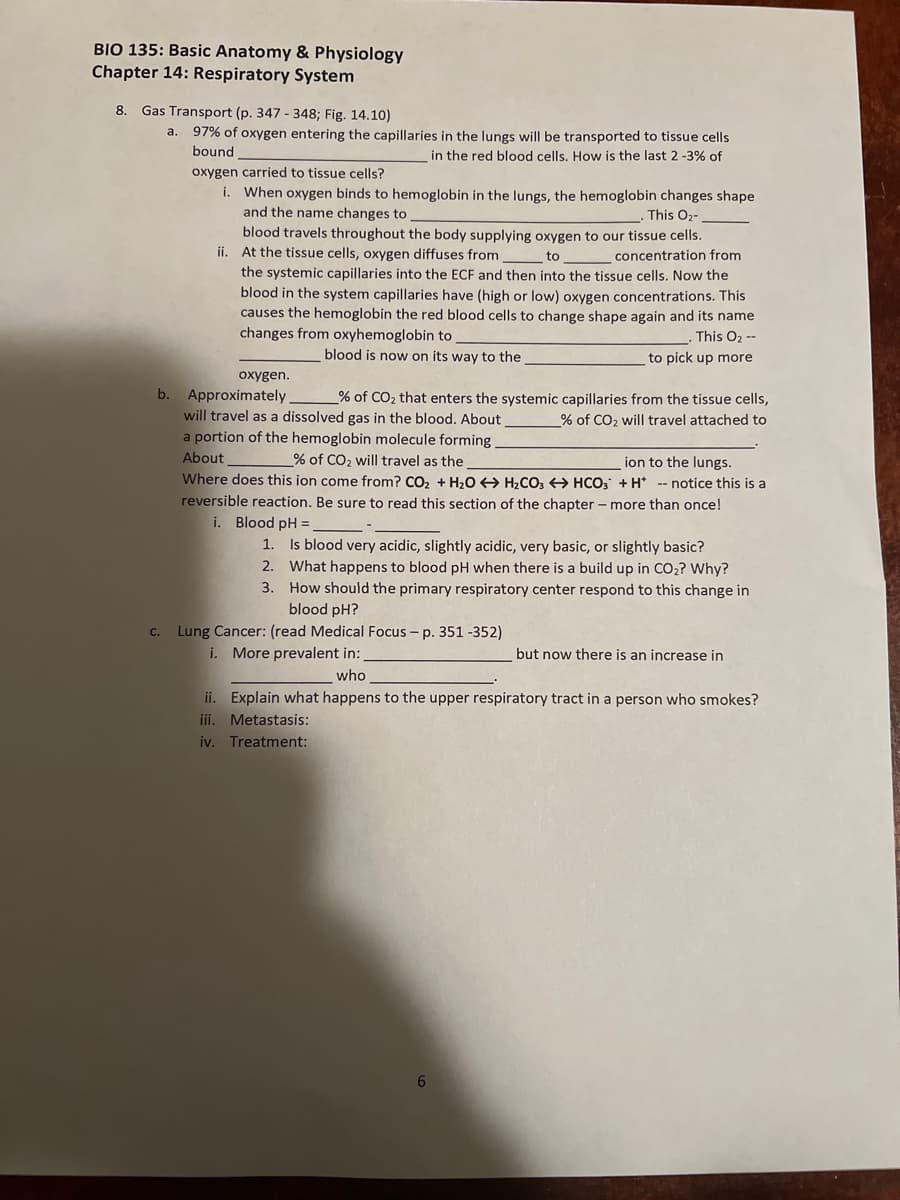BIO 135: Basic Anatomy & Physiology Chapter 14: Respiratory System 8. Gas Transport (p. 347-348; Fig. 14.10) a. 97% of oxygen entering the capillaries in the bound in the re oxygen carried to tissue cells? i. When oxygen binds to hemoglobin in and the name changes to blood travels throughout the body su ii. At the tissue cells, oxygen diffuses fro the systemic capillaries into the ECF a blood in the system capillaries have (I causes the hemoglobin the red blood changes from oxyhemoglobin to
BIO 135: Basic Anatomy & Physiology Chapter 14: Respiratory System 8. Gas Transport (p. 347-348; Fig. 14.10) a. 97% of oxygen entering the capillaries in the bound in the re oxygen carried to tissue cells? i. When oxygen binds to hemoglobin in and the name changes to blood travels throughout the body su ii. At the tissue cells, oxygen diffuses fro the systemic capillaries into the ECF a blood in the system capillaries have (I causes the hemoglobin the red blood changes from oxyhemoglobin to
Human Anatomy & Physiology (11th Edition)
11th Edition
ISBN:9780134580999
Author:Elaine N. Marieb, Katja N. Hoehn
Publisher:Elaine N. Marieb, Katja N. Hoehn
Chapter1: The Human Body: An Orientation
Section: Chapter Questions
Problem 1RQ: The correct sequence of levels forming the structural hierarchy is A. (a) organ, organ system,...
Related questions
Question

Transcribed Image Text:BIO 135: Basic Anatomy & Physiology
Chapter 14: Respiratory System
8. Gas Transport (p. 347-348; Fig. 14.10)
a. 97% of oxygen entering the capillaries in the lungs will be transported to tissue cells
in the red blood cells. How is the last 2 -3% of
bound
oxygen carried to tissue cells?
i. When oxygen binds to hemoglobin in the lungs, the hemoglobin changes shape
and the name changes to
This O₂-
blood travels throughout the body supplying oxygen to our tissue cells.
to
ii. At the tissue cells, oxygen diffuses from
concentration from
the systemic capillaries into the ECF and then into the tissue cells. Now the
blood in the system capillaries have (high or low) oxygen concentrations. This
causes the hemoglobin the red blood cells to change shape again and its name
changes from oxyhemoglobin to
This O₂ --
to pick up more
blood is now on its way to the
oxygen.
b. Approximately.
% of CO₂ that enters the systemic capillaries from the tissue cells,
will travel as a dissolved gas in the blood. About. % of CO₂ will travel attached to
a portion of the hemoglobin molecule forming
About
% of CO₂ will travel as the
ion to the lungs.
Where does this ion come from? CO₂ + H₂O + H₂CO3 HCO3+H* -- notice this is a
reversible reaction. Be sure to read this section of the chapter - more than once!
i. Blood pH =
C.
1. Is blood very acidic, slightly acidic, very basic, or slightly basic?
2. What happens to blood pH when there is a build up in CO₂? Why?
How should the primary respiratory center respond to this change in
blood pH?
3.
Lung Cancer: (read Medical Focus - p. 351-352)
i. More prevalent in:
who
but now there is an increase in
ii. Explain what happens to the upper respiratory tract in a person who smokes?
iii. Metastasis:
iv. Treatment:
6
Expert Solution
This question has been solved!
Explore an expertly crafted, step-by-step solution for a thorough understanding of key concepts.
This is a popular solution!
Trending now
This is a popular solution!
Step by step
Solved in 3 steps

Recommended textbooks for you

Human Anatomy & Physiology (11th Edition)
Anatomy and Physiology
ISBN:
9780134580999
Author:
Elaine N. Marieb, Katja N. Hoehn
Publisher:
PEARSON

Anatomy & Physiology
Anatomy and Physiology
ISBN:
9781259398629
Author:
McKinley, Michael P., O'loughlin, Valerie Dean, Bidle, Theresa Stouter
Publisher:
Mcgraw Hill Education,

Human Anatomy
Anatomy and Physiology
ISBN:
9780135168059
Author:
Marieb, Elaine Nicpon, Brady, Patricia, Mallatt, Jon
Publisher:
Pearson Education, Inc.,

Human Anatomy & Physiology (11th Edition)
Anatomy and Physiology
ISBN:
9780134580999
Author:
Elaine N. Marieb, Katja N. Hoehn
Publisher:
PEARSON

Anatomy & Physiology
Anatomy and Physiology
ISBN:
9781259398629
Author:
McKinley, Michael P., O'loughlin, Valerie Dean, Bidle, Theresa Stouter
Publisher:
Mcgraw Hill Education,

Human Anatomy
Anatomy and Physiology
ISBN:
9780135168059
Author:
Marieb, Elaine Nicpon, Brady, Patricia, Mallatt, Jon
Publisher:
Pearson Education, Inc.,

Anatomy & Physiology: An Integrative Approach
Anatomy and Physiology
ISBN:
9780078024283
Author:
Michael McKinley Dr., Valerie O'Loughlin, Theresa Bidle
Publisher:
McGraw-Hill Education

Human Anatomy & Physiology (Marieb, Human Anatomy…
Anatomy and Physiology
ISBN:
9780321927040
Author:
Elaine N. Marieb, Katja Hoehn
Publisher:
PEARSON